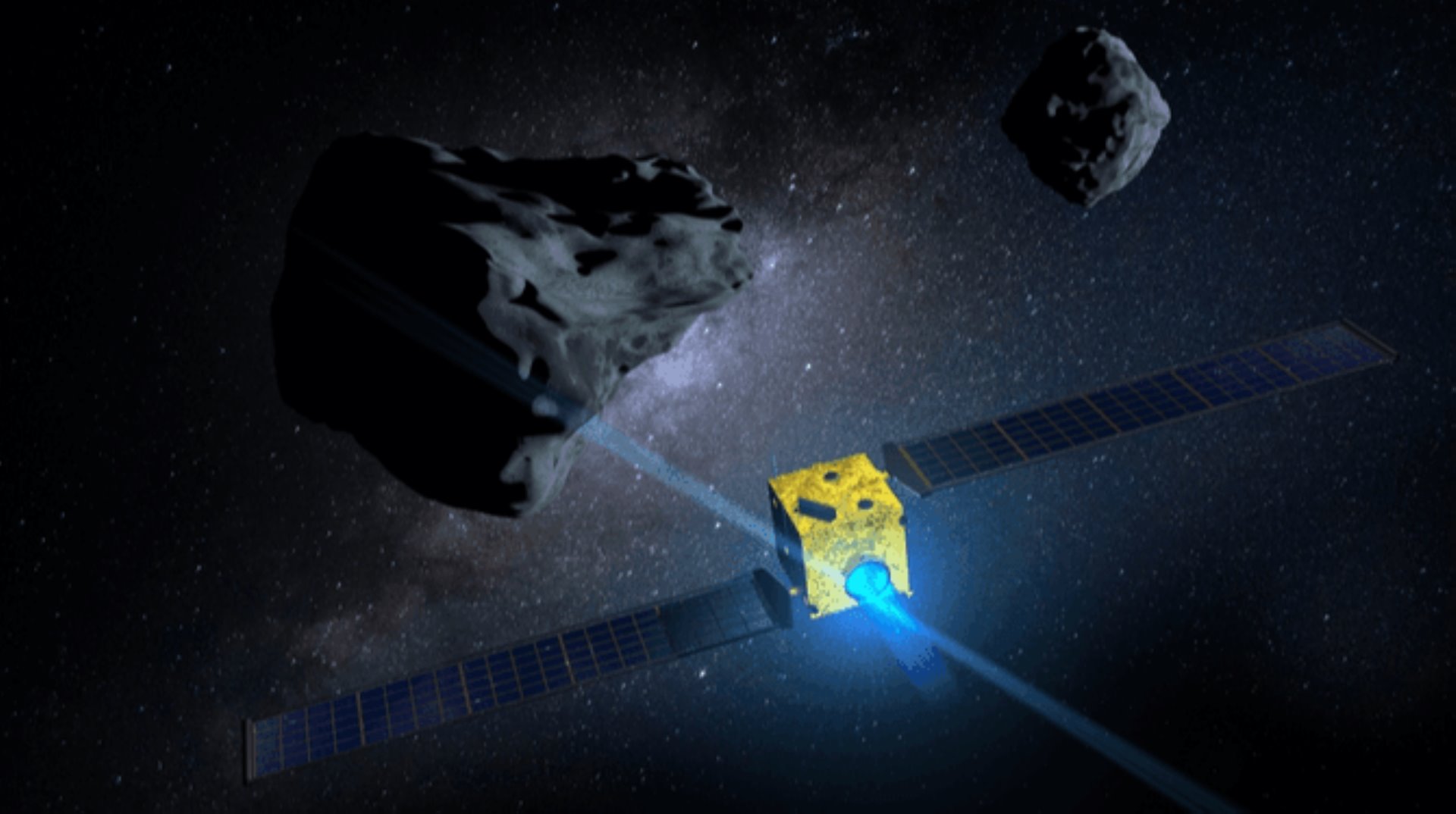Miscellaneous3 - DART
What was going on?
In September 2022, a NASA spacecraft collided with the asteroid Dimorphos:
- This happened at a speed of 6 km/s or about 21 500 km/h.
- DART was a spacecraft the size of a golf cart, costing $300 million.
- Dimorphos was about the size of one of the great pyramids, a fairly regular rock lump of about 160 m.
- The small asteroid Dimorphos has been hovering around the larger asteroid Didymos for an eternity.
The DART probe was launched a year earlier on a SpaceX rocket from a space base in California. So it had been on the road for almost a year and now has more than ten million kilometers on the clock. Successful course corrections were made, but the last kilometers had to be done autonomously. To do this, it is equipped with a camera and with software that can recognize Dimorphos, so that it can fly right on it. Thanks to this camera, we will also be able to experience the last meters of the probe live. At first, Dimorphos will be just a speck in the distance, but we will see the asteroid approaching soon, until the image will suddenly turn black. However, whether the probe will penetrate the asteroid and how deep depends on Dimorphos’ specific parameters. However, these are not yet well known, and certainty will come later.
Since then, every effort has been made to map the effect of that collision. Now we know exactly how powerful DART’s sledgehammer blow was. Instantaneously, the trajectory with which this rock floats through space changed. And that was the intention with a possible collision with the earth in mind. As a result, Dimorphos is now hovering around the larger asteroid Didymos 33 minutes faster than before (the full orbital period would be 24 hours). This is according to a new study published in the journal Nature and it was calculated in advance that it would be around 7 minutes. What certainly played a role is that DART struck about 25 m from the center of the asteroid. As a result, the power of the impact was maximized. The loose boulders on Dimorphos also have something to do with it. After the collision, they flew en masse in the opposite direction. The backlash from that force pushed the asteroid further away from its old orbit. So it’s fair to say that if a dangerous asteroid (similar to Dimorphos) were ever to make its way toward Earth, a spacecraft like DART might succeed in sending the space rock away from our planet.
Of course, photos were taken. In the meantime, a nice piece of technology to be able to take a picture of your own slant:
- It can be seen that Dimorphos was littered with boulders, which didn’t really seem to be stuck to the surface.
- DART first came into contact with one of those boulders, shattering one of the solar panels.
- A split second later, DART exploded on Dimorphos.
- Some time before the collision, a smaller spacecraft separated from the DART probe to follow a slightly different course. The Italian-made craft has to measure the damage that the crashed probe will cause with a well-timed flyby. To do so, he will make a flyby of Dimorphos (about fifty kilometers) exactly three minutes after the crash. According to the researchers, this is the best time to photograph the dust plume and any crater created by the impact.
Some more numbers courtesy of the Hubble Space Telescope photos:
- Before the collision, the total mass of Dimorphos was estimated at 4.3 billion kg.
- At least one million kg of rock was knocked loose in the collision.
- So much debris was released that a long tail of tens of thousands of meters formed behind the asteroid.
- That tail was visible for up to 20 days after impact, photos from the Hubble Space Telescope showed. Other telescopes recorded how the debris tail later changed under the influence of the sun’s rays.
The DART mission was the first in its category. But the method can be used widely and allows you to switch quickly. There is a very good chance that such a mission will succeed. It doesn’t even take a big push to do that. If it is carried out at a sufficiently large distance from Earth, a small orbital correction is enough to send the asteroid flying in a completely different direction. After all, over time, the corrected orbit will become more and more different from the orbit without correction. By the way, people are already well aware of which asteroids are potentially dangerous. And for the time being, none of them are on a collision course with our earth. If an asteroid comes our way soon, we will know what to do.
And there’s another cream of the crop. At the end of 2026, Hera, an ESA spacecraft, will arrive at Dimorphos:
- Astronomers are looking forward to studying the crater that DART made in detail.
- And the far side of Dimorphos will also be photographed, a side that, like the dark far side of the moon, is invisible from Earth.
Is that the only goal?
Of course not, Hera will send herself through the universe just like a self-driving car on the road. It promises to be a unique mission, because Hera will try to find asteroid Didymos completely autonomously. And so you increase the chances of success of the mission.
Can we be 100% optimistic now?
Not quite. New asteroids are spotted every year. The largest ones have been mapped out. But the category just below that isn’t yet. A medium-sized asteroid won’t cause an apocalypse like the one 66 million years ago when the dinosaurs died. But of course, such a medium-sized space boulder can cause a serious disaster on a regional scale.






Comments